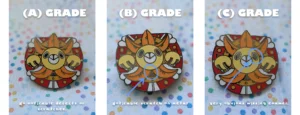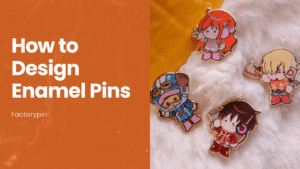If you’ve ever searched for custom pins, you’ve probably seen both “enamel pin” and “lapel pin” thrown around.
Are they the same thing?
Kind of. But not exactly.
Let’s break it down together.
Different Terms, Different Perspectives
Here’s the most important thing to know:
👉 “Enamel pin” and “lapel pin” are two different ways to describe the same item—from different angles.
- “Enamel pin” refers to how the pin is made. If a pin uses enamel—whether soft enamel or hard enamel—it falls under this category.
- “Lapel pin” refers to how the pin is used. A lapel pin is something small and light enough to wear on your clothing, typically on the lapel of a jacket.

So yes, many pins can be both at once.
For example, a 1.5-inch hard enamel pin with a butterfly clutch fits both definitions—it’s made with enamel and wearable on a lapel.
What Makes an Enamel Pin Unique?
An enamel pin is defined by its production method. These pins are crafted by stamping metal and adding enamel-filled colors into recessed areas. You’ll often see:
- Soft enamel pins – with textured surfaces and affordable pricing
- Hard enamel pins – smooth, polished, and more durable
These pins are typically colorful, creative, and come in all sizes—from 1 inch to 4, even 6 inches wide. Large ones are often meant for display boards or ita bags, not clothing.
So while all enamel pins have a decorative purpose, not all are wearable—especially the heavier, oversized ones.

What Makes a Lapel Pin… Lapel?
A lapel pin is defined by its function: it’s meant to be worn—on a jacket, uniform, or hat.
In fact, the name comes from the lapel on a suit jacket, where such pins were traditionally worn to show identity, pride, or affiliation.
Unlike enamel pins, lapel pins:
- Are typically small (1–2 inches)
- Can be made from various materials: die-struck metal, enamel, printed aluminum, etc.
- Prioritize formality and wearability over artistic style
Not all lapel pins use enamel. Some are all-metal, others use print or epoxy domes. What matters is how they’re used, not how they’re made.

Why the Two Terms?
The difference in terminology isn’t just technical—it’s also cultural.
In the United States, the term “lapel pin” became widely used due to its association with military, government, and patriotic symbols. People wore them on their jackets to show support, status, or affiliation. Over time, “lapel pin” became the go-to term for any small pin meant to be worn.
In contrast, “enamel pin” became popular in collector and fan communities, especially in Asia and among artists. It focuses on the craftsmanship and artistic value of the pin rather than its function. Many enamel pin fans don’t wear them—they display or trade them like miniature artworks.
That’s why you’ll often hear American customers say “lapel pin”, while collectors or designers—especially online—say “enamel pin.”
Quick Comparison: Enamel Pin vs Lapel Pin
| Feature | Enamel Pin | Lapel Pin |
|---|---|---|
| Definition | Based on how it’s made (enamel process) | Based on how it’s worn (on clothing) |
| Size Range | Any size (1–6 inches or more) | Usually 1–2 inches, small and wearable |
| Purpose | Collectibles, gifts, branding, art | Fashion, identity, uniforms, events |
| Material/Style | Enamel (soft or hard), metal finishes | Any style—can be enamel or not |
Final Thoughts
Honestly? Either works—depending on your audience.
- If you’re talking to a designer, collector, or artist, they’ll likely say “enamel pin.”
- If you’re speaking with a corporate buyer or formal event planner, they may say “lapel pin.”
What matters most is that you’re clear about what you mean. If you’re making a small wearable enamel pin for a team or event—congrats, it’s both a lapel pin and an enamel pin!
And if you’re ready to make your own custom pins—whether tiny for jackets or large for display—we’re here to help. Just send us your idea, and we’ll bring it to life.





